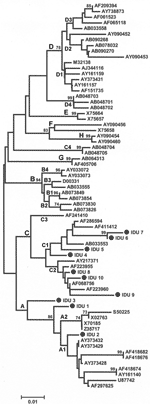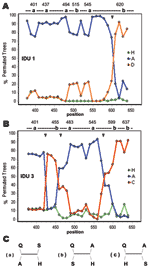Volume 12, Number 12—December 2006
Dispatch
Drug Trafficking Routes and Hepatitis B in Injection Drug Users, Manipur, India
Abstract
Prevalence of hepatitis B genotype C in injection drug users in the northeastern Indian state of Manipur, neighboring the "Golden Triangle," correlates well with overland drug-trafficking routes, the injection drug use epidemic, and the spread of HIV. Further spread to other regions of India through mobile populations is possible.
Injection drug use is common in countries neighboring the "Golden Triangle" (Myanmar, Laos, and Thailand), known for heroin export to other countries. HIV and injection drug use outbreaks in countries neighboring the Golden Triangle, including the northeastern Indian state of Manipur, have been associated with drug-trafficking routes (1). Manipur shares a 358-km porous border with Myanmar. According to the National AIDS Control Organization, India (http://www.nacoonline.org), HIV infection rates among injection drug users in Manipur increased from 2%–3% in 1989 to >50% in 1991 and ≈64% in 2000. In addition, exposure rates of 100% for hepatitis B virus (HBV) and 92% for hepatitis C virus (HCV) have been detected among injection drug users in Manipur, and 95% of wives of injection drug users had HBV exposure (2). However, among both the users and their wives, prevalence of HBV genotypes and occult HBV infection (3), a known risk factor for hepatocellular carcinoma (HCC) (4), remained unknown.
HBV is classified into 8 genotypes, HBV/A through HBV/H, and is further divided into subgenotypes (5) that have a distinct geographic distribution and are associated with different disease outcomes. The geographic distribution of HBV is known to correlate with the anthropologic history of migration (5) and to the origin and routes of spread of HBV infection. In addition, behavioral patterns are known to change HBV genotype distribution in a region (6).
Manipur is an important location, where mainland India (prevalent genotypes HBV/A, HBV/D) geographically meets China and Southeast Asia (prevalent genotypes HBV/B, HBV/C). Our study was designed to detect HBV DNA among injection drug users in Manipur and to analyze HBV genotypes for correlation with injection drug use and the HIV epidemic.
We examined HIV-positive injection drug users from Manipur who had been identified as anti-HBc–positive during previous serosurveys conducted by the National Institute of Cholera and Enteric Diseases (2). Serum samples (stored at –80°C) taken from 63 men 18–25 years of age were available for the study. HBsAg detection was repeated with a monoclonal antibody–based Hepanostika hepatitis B surface antigen (HBsAg) kit (bioMérieux, Marcy l'Etoile, France). Anti-HCV antibody was detected using the Ortho HCV 3.0 test (Ortho-Clinical Diagnostics, Raritan, NJ, USA). We completed HBV DNA isolation, PCR amplification, genotype/subgenotype/subtype identification, recombination detection, and HBV DNA quantification with methods described earlier (7–9). We also compared nucleotide (Table A1) and deduced amino acid sequences (Table) with consensus sequence of amino acids of corresponding genotypes to detect substitutions (GenBank accession nos. DQ356432–DQ356441).
All those tested were HBsAg negative, and only 10 (15.9%) had detectable HBV DNA. Anti-HCV was detected in all but 1 sample (no. 4). Serum HBV DNA level was detectable in 5 of 10 samples (Table); the rest were below the detection limit of our assay.
HBV/C (all subtype adr except 1 adw2) was the predominant genotype, with 4 subgenotype C1 (HBV/C1) and 3 subgenotype C2 (HBV/C2) isolates. HBV/A1 adw2 was found in 1 of the isolates. Two other isolates (nos. 1 and 3, subtype adw2) indicated a possibility of intergenotypic recombination (Figure 1), but subgenotype could not be assigned for them.
BLASTN search (http://www.incogen.com/public_documents/vibe/details/NcbiBlastn.html) of sequence from sample no. 1 showed similarity to HBV/D as well as to HBV/A sequences from European countries. On the other hand, sequences from sample no. 3 showed similarity to HBV/C and HBV/A sequences from Southeast Asian countries and India. Simplot analysis confirmed recombination in these 2 isolates (Figure 2). Apart from the genotype-specific substitutions, deduced amino acid sequences did not have any remarkable escape mutant other than G145R in 2 isolates (Table).
The data from this study showed occult HBV infection in 15.9% of the injection drug users tested. The rate of HBV DNA detection (10%–45%) was considerably different in studies reported from different cohorts of injection drug users in different countries, a finding that has been attributed to coinfection with HCV or low HBV DNA levels (3). Apart from HIV, our study group had a high frequency of HCV infection and low HBV DNA levels. Undetectable HBsAg, except in 2 cases with G145R substitution, may also be a result of the above-mentioned factors.
Although the importance of occult HBV infection is not well understood, a recent study reported occult HBV to be a significant risk factor for HCC, especially among persons who were anti-HBc–positive (4). Another recent study among HIV-infected patients documented death due to liver disease in 22% who were HBV coinfected, 44% who were HCV/HBV coinfected, and 15% who were HBV coinfected and had HCC (10). Thus, the clinical relevance in our study group also needs to be followed.
Although we detected a 100% prevalence of anti-HBc in our serosurveys (2), only 1 was HBsAg-positive. Therefore, the distribution of genotypes among those who were HBsAg positive could not be determined.
Findings of HBV/C1 (prevalent in China) appear to support the history of human migration from China to northeastern India. However, we did not detect HBV/B, also prevalent in China. Further, we did detect HBV/C2, which has close similarity to strains from Southeast Asian countries. The presence of HBV/C correlated well with drug-trafficking routes and the injection drug use epidemic. The geographic proximity of Manipur to the Golden Triangle, needle sharing among injection drug users, and drug traders thus contributed to the spread of HBV through drug-trafficking routes, similar to HIV (1).
In Manipur, HIV subtypes C and Thai B are prevalent (11); these are also prevalent in the India-Myanmar and China-Myanmar border regions. The presence of similar HIV subtypes among injection drug users in Manipur supports the presence of similar HBV strains (e.g., HBV/C1, HBV/C2) and their cotransmission through drug-trafficking routes. In addition, circulation of recombinant HBV is common among injection drug users because of repeated exposure (12). The intergenotypic HBV recombinants found in this study are thus expected. HBV/C has been associated with advanced liver disease and poses a higher risk for HCC in Asians (13) than does HBV/B. However, the clinical relevance of HBV recombinants and their pathogenesis is not well understood and needs further investigation.
Poor, unemployed youths in the northeastern states of India are being recruited for drug trafficking to other regions (http://www.ipcs.org). Furthermore, national highways are associated with the prevalence of injection drug use in rural Manipur (14). As these highways connect Manipur with other parts of India, HBV/C may spread from Manipur to other parts of the country through persons who travel regularly, such as truck drivers and drug traffickers.
Presence of HBV genotypes A and D among patients from northern and western India is well documented. Recent research reported HBV/C with close similarity to Southeast Asian strains only from eastern India (9,15) and suggested injection drug users as a possible route of introduction (15). In addition, persons from northeastern India frequent Kolkata for education, employment, medical treatment, and other purposes. Studies on these mobile populations might provide further important information on the route, population at risk for infection, and changing epidemiology of these viral infections in other regions.
In conclusion, HBV/C, associated with severe liver disease in Southeastern Asia, may be emerging in the Manipur state of India through the trafficking routes of injection drugs. This genotype could spread to the general population through different modes. In light of growing information on the severity of liver disease in HBV-infected HIV/HCV patients, injection drug users should be the focus of additional education and healthcare efforts. The possibility of further spread of HIV/HBV/HCV through mobile populations to other regions of India warrants attention and further investigation.
Mr Datta is senior research fellow at the ICMR Virus Unit, Kolkata, India. His research interests include the molecular epidemiology of HBV, its transmission among family members, genetic variability in the HBs/HBx gene regions, and studies on HBV DNA in extrahepatic sites in persons with HIV/HCV coinfection.
Acknowledgments
We thank Tapan Kumar Chakrabarti for technical assistance.
The University Grants Commission, New Delhi, India, and Indian Council of Medical Research, New Delhi, provided research fellowships.
References
- Beyrer C, Razak MH, Lisam K, Chen J, Lui W, Yu XF. Overland heroin trafficking routes and HIV-1 spread in south and south-east Asia. AIDS. 2000;14:75–83. DOIPubMedGoogle Scholar
- Saha MK, Chakrabarti S, Panda S, Naik TN, Manna B, Chatterjee R, Prevalence of HCV and HBV infection amongst HIV seropositive intravenous drug users and their non-injecting wives in Manipur, India. Indian J Med Res. 2000;111:37–9.PubMedGoogle Scholar
- Torbenson M, Kannangai R, Astemborski J, Strathdee SA, Vlahov D, Thomas DL. High prevalence of occult hepatitis B in Baltimore injection drug users. Hepatology. 2004;39:51–7. DOIPubMedGoogle Scholar
- Pollicino T, Squadrito G, Cerenzia G, Cacciola I, Raffa G, Crax A, Hepatitis B virus maintains its pro-oncogenic properties in the case of occult HBV infection. Gastroenterology. 2004;126:102–10. DOIPubMedGoogle Scholar
- Norder H, Courouce AM, Coursaget JME, Lee SD, Mushahwar IK, Robertson BH, Genetic diversity of hepatitis B virus strains derived worldwide: genotypes, subgenotypes and HBsAg subtypes. Intervirology. 2004;47:289–309. DOIPubMedGoogle Scholar
- Kidd-Ljunggren K, Miyakawa Y, Kidd AH. Genetic variability in hepatitis B viruses. J Gen Virol. 2002;83:1267–80.PubMedGoogle Scholar
- Datta S, Banerjee A, Chandra PK, Chowdhury A, Chakravarty R. Genotype, phylogenetic analysis, and transmission pattern of occult hepatitis B virus (HBV) infection in families of asymptomatic HBsAg carriers. J Med Virol. 2006;78:53–9. DOIPubMedGoogle Scholar
- Lole KS, Bollinger RC, Paranjape RS, Gadkari D, Kulkarni SS, Novak NG, Full length human immunodefficiency virus type 1 genomes from subtype C infected seroconverters in India, with evidence of intersubtype recombination. J Virol. 1999;73:152–60.PubMedGoogle Scholar
- Banerjee A, Kurbanov F, Datta S, Chandra PK, Tanaka Y, Mizokami M, Phylogenetic relatedness and genetic diversity of hepatitis B virus isolates in Eastern India. J Med Virol. 2006;78:1164–74. DOIPubMedGoogle Scholar
- Salmon-Ceron D, Lewden C, Morlat P, Bevilacqua S, Jougla E, Bonnet F, ; The Mortality 2000 Study Group. Liver disease as a major cause of death among HIV infected patients: role of hepatitis C and B viruses and alcohol. J Hepatol. 2005;42:799–805. DOIPubMedGoogle Scholar
- Mandal D, Jana S, Bhattacharya SK, Chakrabarti S. HIV type 1 subtypes circulating in eastern and northeastern regions of India. AIDS Res Hum Retroviruses. 2002;18:1219–27. DOIPubMedGoogle Scholar
- Chen BF, Kao JH, Liu CJ, Chen DS, Chen PJ. Genotypic dominance and novel recombinations in HBV genotype B and C coinfected intravenous drug users. J Med Virol. 2004;73:13–22. DOIPubMedGoogle Scholar
- Chan HLY, Hui AY, Wong ML, Tse AML, Hung LCT, Wong VWS, Genotype C hepatitis B virus infection is associated with an increased risk of hepatocellular carcinoma. Gut. 2004;53:1494–8. DOIPubMedGoogle Scholar
- Sarkar K, Panda S, Das N, Sarkar S. Relationship of national highway with injecting drug abuse and HIV in rural Manipur, India. Indian J Public Health. 1997;41:49–51.PubMedGoogle Scholar
- Vivekanandan P, Abraham P, Sridharan G, Chandy G, Daniel D, Raghuraman S, Distribution of hepatitis B virus genotypes in blood donors and chronically infected patients in a tertiary care hospital in southern India. Clin Infect Dis. 2004;38:e81–6. DOIPubMedGoogle Scholar
Figures
Tables
Cite This ArticleTable of Contents – Volume 12, Number 12—December 2006
| EID Search Options |
|---|
|
|
|
|
|
|


Please use the form below to submit correspondence to the authors or contact them at the following address:
Runu Chakravarty, ICMR Virus Unit, ID and BG Hospital Campus, GB-4, 1st Floor (East Wing), Beliaghata, Kolkata 700 010, India
Top